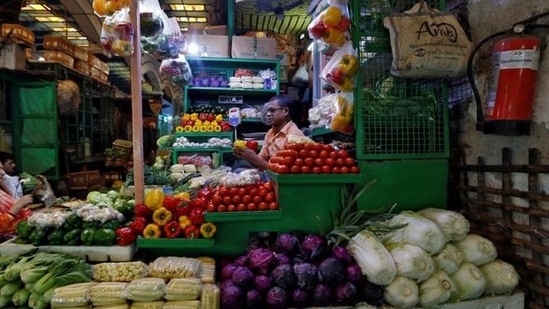Centre considers steps to keep food inflation in check
India’s consumer inflation rate surged to a five-month high of 7.41% in September on an annual basis, compared to a 7% rise in the previous month, breaching the Reserve Bank of India’s target of 2-6% for the ninth straight month, data released on Wednesday showed.
A high-level committee led by the Union department of food and public distribution will likely meet next week to determine further steps to ease prices of essential commodities, a person aware of the development said, listing further restrictions on exports, a drive against hoarding, and the release of buffer stock as possible interventions.

India’s consumer inflation rate surged to a five-month high of 7.41% in September on an annual basis, compared to a 7% rise in the previous month, breaching the Reserve Bank of India’s target of 2-6% for the ninth straight month, data released on Wednesday showed.
The jump in retail prices was driven by broad-based increase in food prices in September, just like in the previous month, with cereals, pulses, vegetables, milk and milk products maintaining a rising trend. Food inflation leapt to a 22-month high of 8.40% in September, complicating the government’s responses so far to bring down prices.
A rise in food prices hurts poor households more because they tend to spend a higher proportion of their monthly budget on staples, milk, vegetables and protein items. It also increases pressure on the Reserve Bank to raise benchmark lending rates to cool inflation, which tends to hurt growth. To be sure, India’s central bank is already in a rate increasing cycle since April that will likely continue till early next year.
“The government is closely monitoring the price situation of all major commodities in the wake of geopolitical scenarios, including extreme weather conditions around the globe,” the person cited above said.
A committee led by the Union department of food and public distribution will “review prices of all major commodities and ensure appropriate timely measures are taken to keep a check on the prices in view of the interest of the farmers, industry and common consumers”, the person said.
The review, likely next week, will take into account the latest price situation and assess effectiveness of measures already in place, the person added. Cereal inflation jumped to 11.5% in September from 9.6% in August, led by wheat/flour and rice.
Wheat inflation at 17.4% in September has been in double digits since June, when supplies dwindled due to a scorching heat wave in March.
Lower kharif or summer-sown rice area, down 4.7% as of September 30 compared to the previous year, and heavy rainfall over the past fortnight have stoked rice inflation, which stood at 9.2% in September, up from 6.9% in August.
The world could face a recession in 2023 amid the simultaneous tightening of monetary policy by central banks around the globe, the World Bank said last month in a new report that called for boosting production and removing supply bottlenecks to ease inflation.
“The seasonal impact of rains on vegetable prices will now become discernible. Going forward, the unseasonal rains in different parts of country up to 700% in cereal producing states could have a significantly large impact on cereal and vegetable prices,” said Soumya Kanti Ghosh, group chief economic adviser of the State Bank of India, in a research note on Thursday.
Discussions on further price-control measures are likely to analyse “possibilities” of a cut in the Agriculture Infrastructure Development Cess on items beyond edible oils, the person cited in the first instance said.
The government is certain to rapidly release significant quantities of onion, a volatile item, to “non-producing states”, or regions that don’t produce the vegetable from a federally held reserve of 250,000 tonne for 2022-23, a second official said.
“The onion release from buffer stock will have two conditions. One, it will be only for non-producing states, such as those in the North-East. Two, buffer-stock onion can’t be released in the vicinity of major onion markets. An initial quantity of 35,000 tonne has already been issued,” this person added, speaking on condition of anonymity.
The onion buffer is maintained by the department of consumer affairs under a price stabilization fund, which aims at effective market intervention to cool prices when availability plunges.
The government had clamped a ban on wheat export in May after extreme weather crimped output. Last month, India also curbed overseas shipments of rice, imposing a 20% duty on them.
The government has so far not intervened in the markets directly through its so-called open market sales scheme (OMSS), which provides federally held cereals to private sellers at a discount.
“However, the government is well aware of the prices scenario and monitoring it regularly. OMSS could be resorted to. India has sufficient stocks ,” the person cited in the first instance said. The department of food is likely to ask states to ramp up steps to detect hoarding and black-marketing of essential items.
Officials said they expect cooking oil prices to be stable, as international prices have declined from their earlier peaks. The all-India retail prices of palmolein, refined soyabean oil, refined sunflower oil and mustard oil decreased by 23%, 12%, 13% and 8%, respectively, in the last five months, official data showed.
Get Current Updates on India News, Lok Sabha Election 2024 live, Infosys Q4 Results Live, Elections 2024, Election 2024 Date along with Latest News and Top Headlines from India and around the world.
Continue reading with HT Premium Subscription





